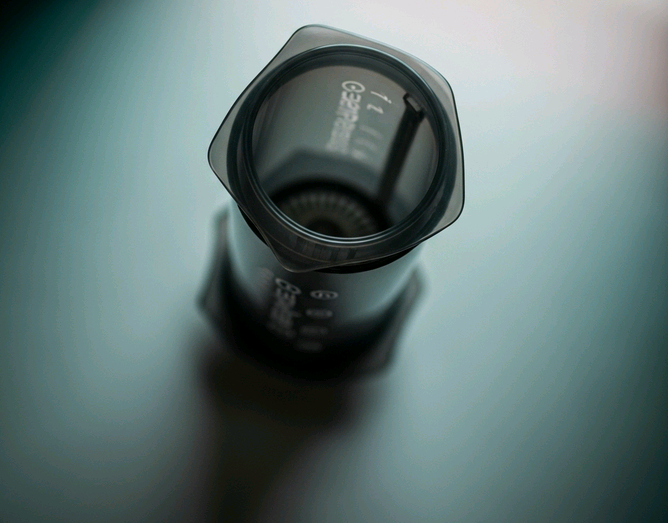Shake Off the Dust: Your Complete Guide to a Dust-Free AeroPress Brew
The AeroPress. A beloved device among coffee enthusiasts, cherished for its simplicity, quickness, and ability to brew an extremely clean, lively cup of coffee. Its reputation is well founded – a portable powerhouse for silky-smooth, grit-free cups. For others, though, a frustrating reality: that dismal layer of “grit” or fine sediment at the bottom of the cup.
If you’ve been having a gritty AeroPress, don’t panic, you’re not alone. It’s a reasonably common problem, but an easily fixed one. As a coffee snob and experienced AeroPress user, I’m here to reassure you that the holy grail of the squeaky-clean cup is easily within reach. Let’s have a look at the causes of AeroPress grit and, more crucially, how to get rid of it for good.
The Number One Culprit: Your Grind Size (And How to Change It)
This is by far the number one reason why you’re experiencing sediment in your AeroPress.
The Issue:
Your grind is simply too fine. Even though the AeroPress is forgiving, an espresso-fine or even a drip-fine grind produces a great deal of very tiny coffee particles, often known as “fines.” Even the AeroPress’s robust paper filter struggles to catch all these small particles, and they pass through into your cup and accumulate at the bottom.
The Fix:
Grind a bit coarser on your grinder. For AeroPress, you want a table salt or perhaps slightly finer grind. If you’re in the pre-ground coffee game, this might be an excuse to shell out some cash for a decent burr grinder because consistency is king. Start coarser than you think you need, brew, and then go incrementally finer until you reach your flavor sweet spot without grit.
Filter Fortification: Powering Up Your Filter
Occasionally, one filter simply isn’t enough to get the job done and catch all of those pesky fines.
The Problem:
While AeroPress paper filters are great, at times one layer can lag behind on fines, especially if your grind is not perfectly uniform.
The Fix 1: Double Paper Filters.
This is an incredibly easy and effective hack. Rather than employing a single standard AeroPress paper filter, use two. This adds another layer of filtering, hugely enhancing your potential to catch up small particles and produce a noticeably cleaner cup. Lots of experienced AeroPress users rave about this trick.
The Fix 2: Rinse Your Paper Filter Well.
Before you put in your coffee beans, always place your paper filter(s) in the cap and rinse them thoroughly with hot water. This has a dual impact: it knocks out any chance of a papery taste and, most crucially, will definitely moisten the filter through and through and seat it tightly against the cap, reducing any tiny openings or loose fibers that might let grit seep through.
Technique Adjustments: Brewing Smarter, Not Harder
Your plunging technique and even your stirring can influence the amount of sediment that makes it into your brew.
Employ the Inverted Method (for less pre-drip):
The Problem:
With the standard AeroPress method, the coffee can start dripping through the filter when water is first poured in, even before you have begun plunging. Premature dripping can introduce fines along with it.
The Fix:
Invert your AeroPress (inverted method). It allows you to pour in water and stir without coffee leaking through the filter cap until you are ready to invert and plunge. It retains all the coffee and fines within until you press.
Press Slowly and Steadily:
The Problem:
Forcing the dip, or pushing too hard and quickly, creates excess pressure and turbulence within the chamber. This can literally push small particles through the filter.
The Fix:
If you’re due for a plunge, apply slow, steady, even pressure. Experiment with a controlled press that should take between 20-30 seconds. Light, firm pressure will leave a cleaner cup.
Stir Gently (If You Stir):
The Problem:
While stirring ensures even extraction, over-stirring can actually result in more fines through additional breakdown of the coffee grounds.
The Fix:
If your recipe requires stirring, stir lightly and for only the recommended time. Over-stirring is preventable and counterproductive to minimizing grit.
Hardware Check: Checking Your AeroPress Parts
Now and then, the issue isn’t your grind or method, but a battered component.
Check the Filter Cap:
The Problem:
From frequent use, the plastic filter cap can develop tiny cracks or become quietly warped by heat and pressure. Even slight damage of a micron or less can break the seal, allowing coffee grounds to leak out of the filter and run into your cup.
The Fix:
Check your filter cap very closely for any apparent damage. If you find any, it’s an inexpensive replacement part.
Check the Plunger Seal:
The Problem:
Your AeroPress plunger tip’s black rubber seal can get worn out, brittle, or ripped after heavy use. A broken seal will not seal well against AeroPress chamber walls, and coffee grounds will seep through it and into your coffee.
The Solution:
Inspect the seal for wear. If it’s stiff, cracked, or loose, new seals are readily available and can be a game-changer for your brew.
The Metal Filter Problem (And Why It Might Not Be “Grit-Free”)
Some AeroPress users experiment with reusable metal filters for environmental friendliness or to provide a different body. But if grit is your first concern, consider the following.
The Reality:
While metal filters filter out paper waste and allow more coffee oils into your cup (making the body richer), they will generally have bigger pores than paper filters. They will thus almost always send more fines and sediment into your finished brew. If your goal is a completely grit-free cup, a metal filter is a compromise, not a solution.
Your Option:
If you enjoy the extra body and aren’t fussy about a little sediment, a metal filter is great. But if you want crystal clear, paper is your best bet.
Conclusion: Your Road to AeroPress Perfection
Having sediment at the bottom of your AeroPress coffee can be infuriating, but it’s an easy fix depending on several key considerations. By systematically adjusting your grind, enhancing your filtration, adjusting your brewing technique, and keeping your AeroPress gear spotless, you can basically eliminate sediment and consistently brew that stunningly clean, silky cup of coffee the AeroPress is famous for. Try these tips, figure out what works best for your equipment, and enjoy every last, grit-free sip!
FAQs
Why is my AeroPress so hard to press?
The most common reason for a hard-to-press AeroPress is a grind that is too fine with too much resistance. Other causes are over-filling the chamber, over-extraction with too much coffee, or a soiled/worn-out rubber plunger seal creating too much friction or insufficiently lubricated by washing.
What is the lifespan of an AeroPress?
An AeroPress is quite long-lasting. If properly cared for and well maintained, an AeroPress will contentedly survive 5-10 years, and often many more, for 20 years or more. The rubber plunger seal is the most probable component to wear out, and is inexpensive and easy to replace.
Why is my AeroPress coffee weak?
Weak AeroPress coffee is usually caused by:
- Too coarse of a grind: The water travels through too quickly, failing to release adequate flavor.
- Too little coffee: Not enough coffee grounds to the amount of water utilized.
- Too short a steep time: The coffee has not been given enough time to be in contact with the water for proper extraction.
- Water not hot enough: Insufficient heat for optimal flavor extraction.
- Not enough agitation/stirring: Inconsistent saturation of the coffee grounds.
Why is my AeroPress sticky?
If your AeroPress is sticky, it is typically because coffee oils and residue have collected on the rubber seal of the plunger and the interior of the chamber. This means a good cleaning beyond rinsing is in order. Rinsing with warm, soapy water or a descaling solution will wipe away the sticky residue.
How to improve AeroPress?
To improve your AeroPress coffee:
- Fresh, quality whole beans and grind right before brewing.
- Experiment with grind size: Experiment with finer (for more concentrated, quicker brews) and coarser grinds.
- Experiment with coffee-to-water ratio: A general starting point is generally 1:15 to 1:17.
- Experiment with water temperature: Aim for 175-205°F (80-96°C) depending on roast.
- Control steep time: Longer for more extraction, and shorter for less.
- Try techniques: Test standard vs. inverted, bloom, and stir techniques.
Opening a stuck AeroPress
A stuck AeroPress usually means that the plunger is hard to push through. Opening it:
- Apply steady, even pressure: Don’t force with too much force, but maintain even pressure.
- Run hot water over the chamber: This can help warm and loosen the rubber seal and break down sticky residues.
- Twist gently: While applying pressure, try a slight twisting motion.
- Ensure it’s clean: A stuck plunger can be a symptom of sticky residue buildup, indicating it needs a deep clean.
How to make a perfect AeroPress?
A “perfect” AeroPress is open to interpretation, but an excellent place to begin includes:
- 15-17g of new, medium-fine ground coffee (similar consistency to table salt).
- 200-220ml of water at 195-205°F (90-96°C).
- Standard or Inverted Method: Add filter, add grounds, add water, stir 10-15 seconds.
- Steep for 1-2 minutes.
- Press slowly and firmly for 20-30 seconds.
Dilute to taste with hot water when concentrating. Experiment to find your perfect recipe.
What are the disadvantages of AeroPress?
The main disadvantages of AeroPress are:
- Small batch size: Typically only produces 1-2 servings of concentrate at once.
- Paper filters: Constant purchase of disposable filters (although a reusable metal filter is available).
- Plastic construction: Although durable, some like to avoid plastic brewing.
- Minimal learning curve for tweaking recipes and techniques.
Can you reuse AeroPress twice?
No, you can’t effectively reuse the same coffee grounds in an AeroPress twice to brew another full cup. The AeroPress extracts nearly all of the soluble coffee solids with one press. Attempting to re-brew exhausted grounds (a process called “re-extraction”) will result in a very weak, over-extracted, and bitter coffee. Fresh grounds are optimal for every brew.
Is AeroPress healthy?
Yes, the AeroPress as a whole is a healthy way to brew coffee. It does not employ French press but uses paper filters instead, which can effectively remove diterpenes (cafestol and kahweol). These compounds, found in unfiltered coffee, can increase LDL (“bad”) cholesterol in certain individuals. Its quick brewing also minimizes contact time with plastics.
How many scoops of AeroPress per person?
The AeroPress scoop will hold approximately 15 grams of coffee if filled level.
- For a single robust concentrate to be diluted into an Americano, 15g (1 scoop) is typical.
- If you like a more robust drink or are preparing a concentrate to make two small drinks, 1.5 to 2 scoops (22-30g total) may be taken, sometimes with less water in the chamber, then diluted down.
- In the end, it is up to you and your preference.

